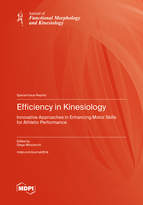Efficiency in Kinesiology: Innovative Approaches in Enhancing Motor Skills for Athletic Performance
A special issue of Journal of Functional Morphology and Kinesiology (ISSN 2411-5142). This special issue belongs to the section "Kinesiology and Biomechanics".
Deadline for manuscript submissions: closed (31 May 2023) | Viewed by 24314
Special Issue Editor
Interests: motor control; motor timing; cognitive-motor mechanisms; adaptive control; kinematics; excellent performance; neurorehabilitation
Special Issues, Collections and Topics in MDPI journals
Special Issue Information
Dear Colleagues,
On behalf of Journal of Functional Morphology and Kinesiology, I am leading a Special Issue about the implementation of innovative applied research to improve motor skills for reaching superior sporting performances.
Investigations from the last several decades have provided enough evidence for the use of certain means as the training foundation for sharpening athletic performance, both from a biomotor and from a technical standpoint.
However, as the field of sports science continues to grow, new methodologies, technologies, and applications for evaluating, improving, or even predicting motor performance draw the attention of the academic realm, infield operators, and general audiences. Nevertheless, sometimes these new means gain wide popularity without apt scientific support, and sometimes the opposite is true—that is, cutting-edge approaches which are well-validated in the lab fail to transfer within the sporting environments.
Seeing the unceasingly evolving nature of sports science as well as the continuous demand for ever-better competitive performance, the development of novel scientific approaches to improve athletes’ motor skills and performances is desired, and their promulgation is of utmost importance for trainers and scientists. Thus, further research is required to grant a deeper understanding of the advantages and limitations in using particular means when aiming to evaluate, predict, and model sporting performance in both amateur and professional/elite athletes.
In this Special Issue, we are looking for original investigations and reviews which introduce novel approaches to defining how leveraging either extrinsic (socio-economic, geographic, early sporting specialization etc.) or intrinsic factors (training periodization, training methodology, equipment, cross-training, recovery management etc.) may help to upgrade athletes’ motor skills to obtain their best athletic performance. Thank Mr. Vincenzo Sorgente as assistant editor for the special issue.
Dr. Diego Minciacchi
Guest Editor
Manuscript Submission Information
Manuscripts should be submitted online at www.mdpi.com by registering and logging in to this website. Once you are registered, click here to go to the submission form. Manuscripts can be submitted until the deadline. All submissions that pass pre-check are peer-reviewed. Accepted papers will be published continuously in the journal (as soon as accepted) and will be listed together on the special issue website. Research articles, review articles as well as short communications are invited. For planned papers, a title and short abstract (about 100 words) can be sent to the Editorial Office for announcement on this website.
Submitted manuscripts should not have been published previously, nor be under consideration for publication elsewhere (except conference proceedings papers). All manuscripts are thoroughly refereed through a single-blind peer-review process. A guide for authors and other relevant information for submission of manuscripts is available on the Instructions for Authors page. Journal of Functional Morphology and Kinesiology is an international peer-reviewed open access quarterly journal published by MDPI.
Please visit the Instructions for Authors page before submitting a manuscript. The Article Processing Charge (APC) for publication in this open access journal is 1600 CHF (Swiss Francs). Submitted papers should be well formatted and use good English. Authors may use MDPI's English editing service prior to publication or during author revisions.
Keywords
- kinesiology
- sport science
- sport performance
- biomechanics
- training periodization
- training prescription
- exercise physiology
- athletic performance
- motor performance
- motor skills







